A Beginner's Guide to the Hario V60 Ceramic Dripper
The Hario V60 is a famous tool for making pour over coffee. Many of the best coffee shops use it. This guide is for the ceramic version, which is a popular choice because it looks great and lasts a long time.
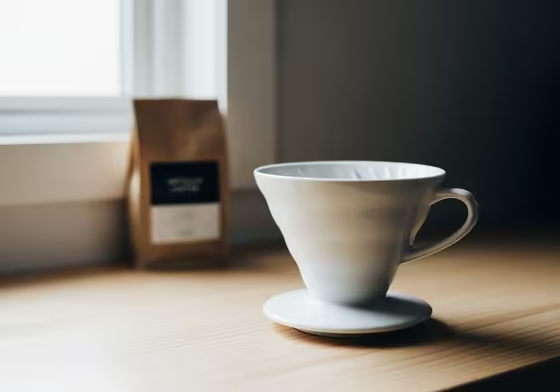
Here, you'll learn what the V60 is and how to use it. We'll also cover how to fix common brewing mistakes. You'll be making great coffee in no time.
What Makes the Hario V60 Special?
The V60 has a simple and smart design. Its name comes from its V-shape and its 60-degree angle. Three main features work together to make it brew coffee so well.
- The 60-Degree Cone Shape: This cone shape lets the coffee grounds stack up deeply. This changes how water flows through them during brewing.
- The Big Hole at the Bottom: Many coffee drippers have small holes to slow the water down. The V60 has one large hole. This gives you full control over the brewing speed.
- The Spiral Ridges: The ridges on the inside walls are not just for looks . They create a small gap between the paper filter and the dripper. This lets air escape and helps the coffee extract evenly.
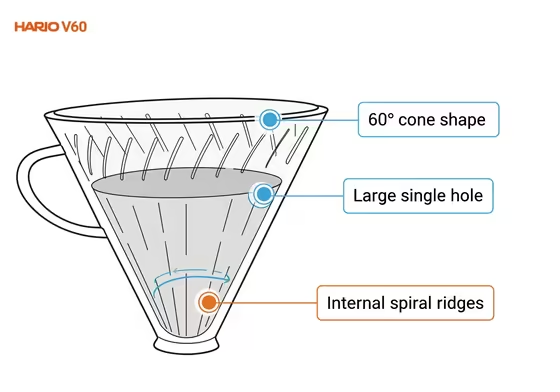
These three things make the V60 a fast brewer that responds to how you pour. You control the brewing speed with your coffee grind size and how fast you pour the water. This gives you a lot of control over the final taste.
Pouring quickly can make a lighter coffee. Pouring slowly can make a stronger, heavier coffee. The V60 takes some practice, but this control is why so many pros love it.
Why Choose the Ceramic Model?
Picking a ceramic V60 over plastic or metal is a specific choice. The material has its own benefits.
It Doesn't Affect the Taste
The main benefit of ceramic is that it doesn't change the flavor of your coffee. The glazed ceramic material won't absorb coffee oils or add any taste of its own. This means you only taste the coffee and the water you used.
It Holds Heat Well
Ceramic is thick and heavy, so it can hold a lot of heat. This can be good or bad. If you pour hot water into a cold ceramic V60, the ceramic will suck a lot of heat out of your water. This can lead to a sour, weak cup of coffee.
To get the benefit of ceramic, you must preheat it . Pouring hot water into the V60 before you add coffee warms it up. A properly heated ceramic dripper keeps a very stable temperature , which helps you brew a better-tasting cup.
Is the Ceramic V60 a Good Brewer?
How It Performs
When you use it correctly, the Hario V60 makes an amazing cup of coffee . It is known for brewing a clean, sweet, and balanced cup. It brings out the more subtle flavors in the coffee beans.
The ceramic model's performance depends on you preheating it properly. When you do, the ceramic holds a steady temperature for a great extraction. It’s a fantastic way to brew coffee.
How It's Made
The ceramic V60 feels solid and high-quality. The Japanese porcelain gives it a nice weight that the plastic version doesn't have. It’s a good-looking piece of equipment that makes your coffee routine feel special.
The main downside is that it's fragile . If you drop it, it can chip or break. But with care, it will last much longer than plastic, which can stain or wear out over time.
Is It Good for Beginners?
The V60 can be tricky for beginners . It takes some practice to get your pour just right. Other brewers with flat bottoms can be more forgiving if you are just starting out.
The ceramic V60 is a great choice for a certain kind of beginner. It's for someone who enjoys the process of making coffee and wants to master a skill. It's a professional tool that you can grow into instead of a starter tool you'll quickly replace.
Which V60 Size Should You Get?
Hario's sizing can be confusing. The 01, 02, and 03 sizes don't match up with normal coffee mugs. A Hario "cup" is very small, so it's better to think about how much coffee you want to make.
All three sizes have the same 60-degree shape. The 02 is just a taller version of the 01, and the 03 is a taller 02. This means you can brew a small batch in a larger dripper without any problems.
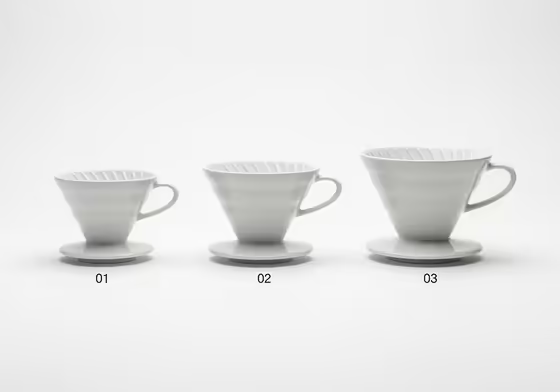
This table gives a simple guide to V60 sizes.
| Size | Typical Coffee Dose | Makes About This Much | Best For... |
|---|---|---|---|
| 01 | 12g – 25g | 180ml – 350ml | Someone who only ever makes one cup at a time. |
| 02 | 20g – 40g | 300ml – 600ml | The best all-around choice. Great for one big mug or two smaller cups. |
| 03 | 40g – 60g+ | 600ml – 1000ml | Making coffee for several people or a family. |
Hario V60 Ceramic 01 (1-2 cups)
This is the smallest dripper, made for single, small cups of coffee. Since it's smaller, it doesn't need as much hot water to preheat. Its main downside is that you can't really make coffee for two people with it.
Hario V60 Ceramic 02 (1-4 cups) - Most popular for beginners
This is the most common size and the one we recommend for most people. It is the best choice for a beginner for a few key reasons.
- Versatility: You can brew a single cup for yourself or make enough for a friend. It gives you flexibility.
- More Forgiving: The larger size is a bit more forgiving if your pouring technique isn't perfect yet.
- Holds Heat Better: Once you preheat it, the larger ceramic body holds a more stable temperature than the smaller 01 size.
Hario V60 03 (1-6 cups)
This is the largest size, made for brewing big batches for a group. It is important to know that the V60 03 is almost always sold in plastic. While a ceramic 03 might exist, it's very hard to find.
Ceramic vs. Plastic V60
This is the biggest question for new V60 buyers. The plastic V60 is also a great brewer, but it’s different from the ceramic one. The choice comes down to heat, durability, and looks.

The following table shows a direct comparison.
| Feature | Hario V60 Ceramic | Hario V60 Plastic |
|---|---|---|
| Heat | Needs to be preheated well. Once hot, it keeps a very stable temperature. | Doesn't absorb much heat. Heats up instantly and is more forgiving if you forget to preheat. |
| Flavor | Perfect. The glazed ceramic is neutral and will never add or absorb flavors. | Excellent. It's BPA-free. Over many years, it might stain or hold onto coffee oils. |
| Durability | Low. It's fragile and can break if you drop it. | Very High. It's nearly indestructible, which makes it great for travel. |
| Price | Moderate. Costs about $25-$35. | Low. Usually costs about $12. |
| Looks | High. It has a high-quality feel and looks great on a counter. | Low. It looks and feels like a simple plastic tool. |
Which is better for beginners?
Many coffee pros prefer the plastic V60 because it's so convenient. It doesn't really need to be preheated, so it's easier to get a good brew. It's also cheap and durable, making it perfect for travel.
The ceramic V60 is more about the experience of brewing. Its downsides, like being fragile and needing to be preheated, are just part of the routine. The benefits are pure flavor and the classy look it brings to your coffee setup.
Here's the bottom line:
- Choose Plastic if: You want the cheapest, most durable option. It's great for travel or if you want consistent coffee with less effort.
- Choose Ceramic if: You are setting up a coffee station at home and care about how it looks. You'll need to learn the extra preheating step, but you get pure flavor and a high-quality tool.
Color Options and Starter Kits
Color Choices
One of the fun parts of the ceramic model is the number of color choices available.
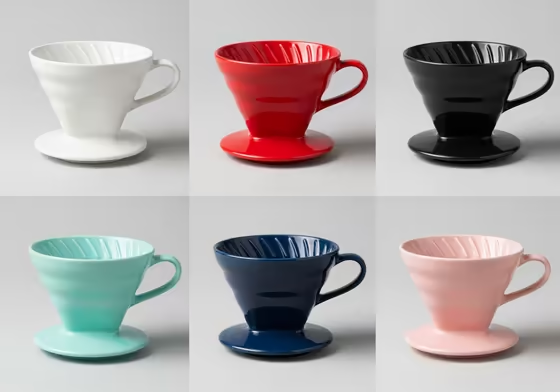
- Classic Colors: The original and most common colors are Red and White.
-
New Colors: Hario often releases new colors, including:
- Matte Black
- Grey
- Turquoise
- Matte Pink
- Navy
- Purple Heather
- Special finishes, like "Saddle"
While the choice is mostly about looks, many pros like the white ceramic version. It makes it easy to see if the dripper is perfectly clean inside.
About the Starter Kits
Beginners often look at starter kits, but you should be careful. The most common "Hario V60 Starter Set" actually comes with a plastic V60, not a ceramic one. It also includes a glass server and some filters.
Real ceramic sets do exist. They usually include the ceramic V60 02, a glass server, filters, and a plastic coffee scoop.
Should You Buy a Set?
A set can be a good gift or a simple way to get started. It's sometimes a little cheaper than buying the parts separately. The glass server is nice if you plan on making coffee for two people.
But many coffee experts suggest you skip the set. The glass server isn't necessary. You can just brew the coffee directly into your mug.
Your money is better spent on the tools that really matter for great coffee. A true starter set should include these four things:
- A V60 Dripper (Ceramic 02)
- V60 02 Paper Filters
- A Digital Scale (reads to 0.1g)
- A Gooseneck Kettle (for better pouring control)
The scale and gooseneck kettle will improve your coffee way more than the glass server will. So, our advice is to buy the V60 dripper and filters on their own. Use the money you save to get a good scale and kettle.
How to Brew Coffee with the Ceramic V60
There are tons of different V60 recipes out there. This recipe is a simple starting point designed for a beginner using the ceramic 02. It focuses on the basics to get you a great cup.
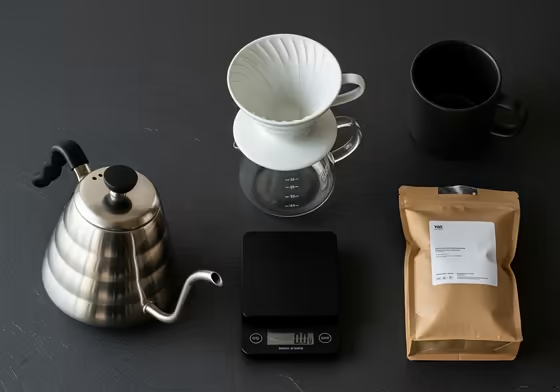
A Simple Recipe for Beginners
| What | How Much | Why it Matters |
|---|---|---|
| Dripper | Hario V60 Ceramic 02 | The best all-around size to start with. |
| Coffee | 20g | A good dose for making one large mug in the 02 size. |
| Water | 320g (or 320ml) | This creates a balanced 1:16 coffee-to-water ratio. |
| Grind Size | Medium-Fine (like table salt) | This is the most important setting to adjust for taste. |
| Water Temp | 205°F / 96°C | Just off a boil. Hot water is needed to extract flavor properly. |
| Total Time | Around 3 minutes | This is a guideline, not a strict rule. Taste is what really matters. |
Step-by-Step Brewing Guide
Step 0: Get Your Tools
You'll need your ceramic V60, a paper filter, a mug, coffee beans, a grinder, a digital scale, a timer, and a gooseneck kettle. The scale and kettle are very important for making good coffee every time.
Step 1: Preheat Everything (Do Not Skip This!)
Fold the paper filter along its seam and put it in the V60. Place the V60 on top of your mug, and put both on the scale. Pour hot water over the filter until it's completely wet.
This does two important things. First, it rinses out any papery taste from the filter. Second, it heats up the ceramic dripper and your mug. Let the water sit for 30 seconds, then dump it out.
Step 2: Add Coffee
Put the V60 and mug back on the scale. Add 20g of your ground coffee. Gently shake the V60 to make the bed of grounds flat and level, then press "tare" or "zero" on your scale.
Step 3: The Bloom (0:00 – 0:45)
Start your timer and slowly pour 50g of water over the coffee, making sure to wet all the grounds evenly. You should see the coffee bubble up and expand as it releases gas. Let it sit for 45 seconds.
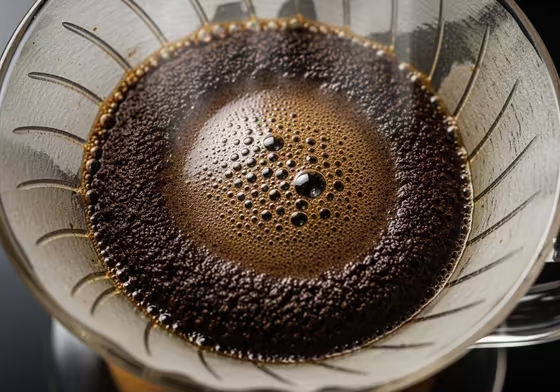
Step 4: The Main Pour (0:45 – 2:00)
At 45 seconds, begin pouring the rest of your water.
- Technique: Pour slowly and steadily in a circular motion. Start in the center and spiral outwards, but try not to pour directly onto the paper filter itself.
-
Pour in stages:
- At 0:45, pour slowly until the scale reads 190g.
- Pause for a few seconds and let the water level drop a little.
- Around 1:30, start pouring again in slow circles until the scale reads 320g.
Step 5: Let It Drain (2:00 – 3:15)
Now, just let all the water drain through the coffee. This should finish around the 3-minute mark.
Step 6: Taste and Adjust
Once the dripping stops, remove the V60 from your mug and enjoy your coffee. Remember that the brew time is just a guide. The most important thing is how the coffee tastes .
Use the taste to decide how to adjust your grind for the next cup. This is the key to getting it just right.
- If it tastes bitter or harsh, your brew took too long. You should make your grind coarser next time.
- If it tastes sour or weak, your brew was too fast. You should make your grind finer next time.
How to Fix Common Brewing Problems
Even with a good recipe, you might run into problems. The V60 is sensitive, so small mistakes can change the taste a lot. Here’s a guide to the most common issues.
V60 Troubleshooting Guide
| Problem | What It Tastes Like | Why It Happens | How to Fix It |
|---|---|---|---|
| Bitter Coffee | Tastes harsh, dry, or too strong. | Your grind is too fine. The water spent too much time with the coffee and pulled out bad flavors. | Grind Coarser. This will make the water flow through faster. |
| Sour Coffee | Tastes sour, salty, or weak. | Your grind is too coarse. The water flowed through too fast and didn't have time to extract the good stuff. | Grind Finer. This will slow the water down. |
| Clogged Brew | The coffee takes 5+ minutes to drain. Tastes muddy and bitter. | Your grind is way too fine. Or, you poured too fast and hard, which clogged the paper filter. | First, try grinding coarser . Also, be sure to pour gently and in slow, controlled circles. |
| Inconsistent Results | One cup is great, the next is bad, even though you used the same recipe. | You probably missed a step or did something differently without realizing it. | Be consistent. Did you really preheat the ceramic dripper? Did you use a scale and timer? Try to do every step the exact same way each time. |